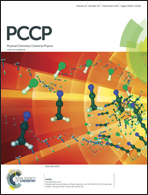Structure and conformational analysis of the anti-HIV reverse transcriptase inhibitor AZT using MP2 and DFT methods. Differences with the natural nucleoside thymidine. Simulation of the 1st phosphorylation step with ATP†
Abstract
A comprehensive quantum-chemical investigation of the conformational landscape of the HIV-1 reverse transcriptase inhibitor AZT (3′-azido-3′-deoxythymidine) nucleoside analogue was carried out. The whole conformational parameters (χ, γ, β, δ, ϕ, P, νmax) were analysed as well as the NBO charges. The search located at least 55 stable structures, 9 of which were by MP2 within a 1 kcal mol−1 electronic energy range of the global minimum. Most conformers were anti or high-anti around the glycoside bond and with North sugar ring puckering angles. The distribution of all the conformers according to the ranges of stability of the characteristic torsional angles was established. The results obtained were in accordance with those found in related anti-HIV nucleoside analogues. The best conformer in the anti form corresponded to the calculated values by MP2 of χ = −126.9°, β = 176.4° and γ = 49.1°. An analysis of the lowest vibrations in conformer C1 was carried out. The first hydration shell was simulated and the structural differences with the natural nucleoside deoxythymidine (dT) were determined. The first phosphorylation step was simulated by interacting ATP with the best hydrated clusters of AZT and dT. The Na cations act as a bridge between the phosphate moieties of ATP making it easy for –P3O3 to receive the H5′ proton from AZT or dT. A proton-transfer mechanism is proposed through the water molecules. When the number of the water molecules surrounding AZT is lower than 8, the first phosphorylation step of AZT can be carried out. However, the appropriate orientation of the O5′–H in dT avoids this limitation and it can be performed with large numbers of water molecules.


 Please wait while we load your content...
Please wait while we load your content...